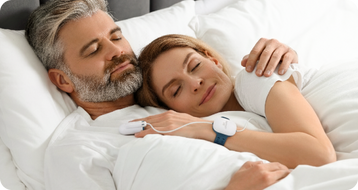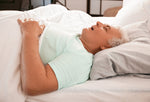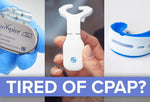On This Page
CPAP Alternatives
Our editorial process includes extensive measures to verify accuracy, provide clarity on complex topics, and present factual information. Read more
Key Takeaways
- Alternative PAP devices like BiPAP and APAP may be effective options, depending on individual breathing patterns and the type of sleep apnea.
- Oral appliances like mandibular advancement devices (MADs) and tongue-retraining devices (TRDs) reposition the jaw and tongue to prevent airway collapse.
- Lifestyle changes, such as losing weight, changing sleep position, and reducing alcohol or tobacco use, play a major role in managing sleep apnea alongside or instead of CPAP.
- Surgery may be considered when other treatments have been unsuccessful or are not suitable.
Alternative PAP Devices
CPAP machines are only one way of using pressurized air to keep the windpipe open and reduce blockages. Other PAP devices may be appropriate, depending on a person’s needs and the type of breathing disruptions they experience.
BiPAP
Bilevel positive airway pressure (BiPAP or BPAP) offers two different levels of air pressure: one during inhalation and another during exhalation. Both pressure levels are preset by a doctor based on the results of a sleep study. BiPAP may be appropriate for people who can't tolerate the continuous pressure provided by CPAP machines and those with more complex breathing issues.
APAP
Also called auto-adjusting CPAP or auto-titrating BPAP, auto-adjusting positive airway pressure (APAP) automatically adjusts air pressure as needed during the night. Because adjustments are made automatically, APAP devices don't require a separate titration study to determine the appropriate pressure settings.
EPAP
Expiratory positive airway pressure (EPAP) is an emerging treatment for OSA that uses disposable valves that are inserted into or over the nostrils. When the sleeper exhales, the valves block airflow and create enough pressure to keep the airway open. Although more research is needed, this treatment may be appropriate for people who have mild to moderate OSA and have trouble with a CPAP machine.
cNEP
Continuous negative external pressure (cNEP) is an investigational treatment for OSA. Unlike many PAP devices, cNEP machines don't use a mask and don't cover the nose or mouth. Instead, the cNEP system features a silicone collar that's worn around the neck and is attached to a vacuum pump by a flexible tube. The vacuum creates negative pressure inside the collar, which pulls the tissues of the throat to keep the airway open.
Oral Appliances
Oral appliances position the jaw or tongue to keep the upper airway open. Although these devices are an alternative to CPAP therapy for people who can't tolerate continuous airway pressure, some people benefit from using an oral appliance alongside CPAP therapy.
Mandibular Advancement Devices
Mandibular advancement devices (MAD) are mouthpieces that shift the jaw slightly forward to enlarge the airway and prevent it from collapsing. MADs come in one- and two-piece varieties and are often custom-fitted.
Tongue Retaining Devices
Tongue retaining devices (TRD) use suction to draw the tongue partially out of the mouth, helping prevent the base of the tongue from blocking the airway. Though additional studies are needed, these devices may be a reasonable alternative for people without teeth or who can't use other oral devices.
Weight Loss
Experts estimate that obesity contributes to up to 60% of moderate to severe OSA cases. Excess weight, particularly around the neck and upper airway, can narrow the throat and make it more likely to collapse during sleep. Because of this, doctors often recommend weight loss as a first-line treatment for people with OSA who are overweight or have obesity.
Even modest weight loss (about 5% to 10% of body weight) can lead to significant improvements in sleep apnea severity and snoring. For individuals who struggle to lose weight through diet and exercise alone, medical and surgical options may be considered.
Bariatric Surgery
Bariatric surgery, which alters the digestive system to promote substantial and sustained weight loss, has been shown to reduce the frequency of apnea events and improve oxygen levels during sleep. However, it's typically only recommended for people with severe obesity or obesity-related complications, and sleep apnea may not always resolve completely after surgery.
GLP-1s for Sleep Apnea
In recent years, GLP-1 receptor agonists such as semaglutide (Wegovy and Ozempic) and tirzepatide (Zepbound) have emerged as promising alternatives. These medications promote weight loss by regulating appetite and blood sugar levels. Early studies suggest they may also reduce sleep apnea severity by helping people achieve and maintain a healthier weight.
Because every case is different, weight-loss strategies should be discussed with your doctor, who can tailor recommendations based on your medical history, sleep apnea severity, and overall health.
Lifestyle Changes
Rather than an alternative to CPAP, these behavioral changes are often recommended in addition to CPAP and other treatments.
Positional Therapy
For many people, sleep apnea symptoms are worse when lying on their back. This position allows the tongue and soft tissues in the throat to fall backward, narrowing the airway.
Positional therapy focuses on training people to sleep on their side instead, which can help reduce the number and severity of apnea events. Techniques range from simple strategies like using a body pillow or special backpack to wearable devices that gently vibrate when you roll onto your back during sleep.
Myofunctional Therapy
Myofunctional therapy involves exercises that strengthen the tongue and muscles in the mouth, and throat to help prevent airway collapse during sleep. This therapy typically includes daily movements such as pressing the tongue to the roof of the mouth, controlled swallowing, and soft palate exercises.
Research shows that regular practice—usually under the guidance of a speech-language pathologist or myofunctional therapist—can reduce snoring and decrease the severity of mild to moderate obstructive sleep apnea.
Quit Smoking and Avoid Alcohol
Reducing alcohol and tobacco use may be helpful for lessening the symptoms of OSA. Drinking alcohol before bed can worsen OSA, promote snoring, and depress the central nervous system. Smokers are more likely to snore and are at an increased risk of sleep-related breathing disorders like OSA when compared to nonsmokers.
Exercise
Physical activity has also been shown to improve symptoms of OSA, even among individuals who do not lose weight. Exercise strengthens the muscles involved in breathing, reduces inflammation, and can improve cardiovascular health and oxygen efficiency during sleep.
Surgery
Sleep apnea surgery can be used in several different circumstances. As a first-line treatment, surgery may be recommended prior to CPAP therapy in people who have a blockage in their airway that can be fixed with a surgical procedure.
Surgery can also be performed to help people better tolerate CPAP therapy or an oral appliance by addressing physical features that interfere with these other treatments for OSA. As an alternative therapy, surgery may be recommended for people who can't tolerate CPAP or prefer a different treatment.
There are many surgical procedures used to treat OSA. The type of surgery a person undergoes depends on multiple factors, including their anatomy and both the site and underlying cause of their airway obstructions.
Uvulopalatopharyngoplasty
Uvulopalatopharyngoplasty (UPPP) involves reducing the chances of airway collapse by addressing features of the mouth and throat that contribute to sleep-induced blockages. Surgery often alters the shape and position of the soft palate, which is the rear portion of the roof of the mouth. UPPP is the most common type of surgery used to treat OSA.
Lower Airway Surgery
Surgeries to the lower airway resolve blockages or collapse caused by the tongue or epiglottis, which is the piece of tissue that prevents food from entering the lungs when a person swallows. More than one-third of people with OSA have obstructions in the lower airway, making these surgeries a potential alternative for many people.
Maxillomandibular Advancement Surgery
Maxillomandibular advancement is a surgery that pushes the jaw and other tissues forward. This procedure tightens the inner walls of the throat to reduce the risk of airway collapse. People who have maxillomandibular advancement surgery must wear orthodontic appliances before and after the procedure.
Hypoglossal Nerve Stimulation
Hypoglossal nerve stimulation is a treatment for obstructive sleep apnea that uses a surgical procedure to implant a device in the upper chest. This device stimulates the hypoglossal nerve that causes the tongue to move forward in the mouth and expand the airway. A remote control is used to turn on the device at bedtime.
When to Talk to Your Doctor
Before considering an alternative to CPAP therapy, it’s important to discuss any concerns or challenges about this treatment with your doctor. Although adjusting to CPAP therapy can come with its challenges, many side effects of CPAP can be prevented or resolved by working with a health professional.
Your doctor can also discuss alternatives to CPAP if you're unable to use CPAP therapy, if it has not been effective for you, or if you simply want to explore your other options. Although CPAP remains the treatment of choice for many people with obstructive sleep apnea, several alternatives are available to help reduce breathing issues and resolve daytime symptoms.










